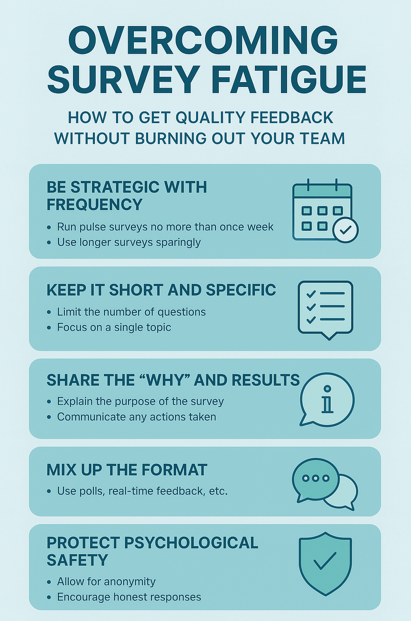You know that collecting employee feedback is critical for diagnosing workplace productivity, but what happens when surveys start to feel more like spam than support?
Survey fatigue is real. And it’s one of the top reasons companies struggle to gather meaningful, actionable data. But with the right approach, you can design a feedback strategy that gets high participation and valuable insights, without exhausting your people.
At Productivity Advocates, we believe in feedback loops that fuel change, not burnout. Here’s how to fix survey fatigue and make your surveys work smarter, not harder.
🚩What Is Survey Fatigue—and Why It Matters
Survey fatigue happens when employees feel overwhelmed, disillusioned, or simply uninterested in providing feedback—often because they:
- Get asked too often
- Don’t see change after they respond
- Feel surveys are too long, vague, or impersonal
Why it’s a problem:
Low response rates and superficial answers lead to incomplete data. That means decisions are made based on partial truths—or worse, guesswork.

✅ 1. Be Strategic with Frequency
More is not always better. Frequent surveys with no clear purpose can erode trust. Instead:
- Run pulse surveys no more than once per week (1-3 questions max)
- Save longer surveys for quarterly or biannual deep dives
- Align timing with your workflow (e.g., after major projects, not during crunch time)
📌Pro tip: Ask yourself, “What action will we take from this feedback?” If there’s no clear answer, skip the survey.
✅ 2. Keep it Short and Specific
Long surveys = lower completion rates. Instead:
- Ask targeted questions tied to real pain points (e.g., “How clear was your role in the last project?”)
- Use Likert scales and open text fields sparingly
- Focus on one theme per survey (e.g., meetings, communication, workload)
📖 Read more about survey design best practices
✅3. Share the “Why” and the “What Happened Next”
Employees are more likely to engage when they see that:
- Their feedback matters
- It led to something
After each survey:
- Share top-level insights and themes
- Communicate actions being taken (or why change isn’t happening yet)
- Keep the loop transparent, even if the answer is “we’re still evaluating options”
✅4. Mix Up the Format
Surveys don’t always need to be forms in an email. Try:
- 1-question polls in Slack or Teams
- Real-time feedback tools during meetings
- Video or audio prompts for open-ended thoughts
Using a variety of formats reduces monotony and meets employees where they are.
✅5. Protect Psychological Safety
If your surveys ask people to be honest—but your culture punishes dissent—responses will be skewed or sanitized.
Make sure:
- Surveys are anonymous (or explain clearly when they’re not)
- Leaders encourage all perspectives—even uncomfortable ones
- Feedback never results in individual targeting
📊Better Feedback = Better Decisions
Solving survey fatigue doesn’t mean sending fewer surveys. It means sending better ones—rooted in intention, designed with clarity, and followed up with action.
At Productivity Advocates, we build feedback systems that reveal the true drivers of productivity. Our surveys are short, strategic, and aligned to your goals—not just your inbox.
👉 Ready to get real insights without exhausting your team?

